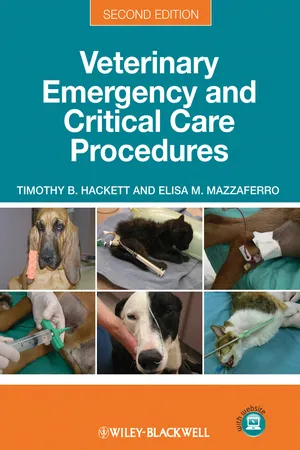
Veterinary Emergency and Critical Care Procedures
- English
- ePUB (mobile friendly)
- Available on iOS & Android
Veterinary Emergency and Critical Care Procedures
About This Book
Veterinary Emergency and Critical Care Procedures, Second Edition is a step-by-step guide to key emergency and critical care procedures encountered in bothgeneral and specialty practice. Now in full color, the second edition includes several new procedures, two new chapters covering cardiopulmonary resuscitation and continuous rate infusions, and a companion website offering videos demonstrating most of the procedures featured in the book. Helpful hints have also been added throughout to make the book even more useful in the practice setting.
Each procedure includes information on the background, supplies needed, indications, and contraindications, followed by a series of images demonstrating the technique. This practical resource, ideally designed for use in fast-paced emergency situations, is an indispensable reference for any member of the veterinary team.
Frequently asked questions
Information
CHAPTER 1
Vascular Access Techniques
INTRODUCTION
CENTRAL VENOUS CATHETER PLACEMENT
Introduction
Supplies Needed
Indications
Contraindications

Go to www.wiley.com/go/hackett to view a video of this procedure.



Table of contents
- Cover
- Series page
- Title page
- Copyright page
- Preface
- CHAPTER 1: Vascular Access Techniques
- CHAPTER 2: Nutritional Support and Orogastric Lavage
- CHAPTER 3: Thoracocentesis and Thoracostomy Tube Placement
- CHAPTER 4: Oxygen Supplementation and Respiratory Sampling Techniques
- CHAPTER 5: Urinary Catheter Placement, Urohydropulsion, and Temporary Antepubic Cystostomy Catheter Placement
- CHAPTER 6: Abdominocentesis and Diagnostic Peritoneal Lavage
- CHAPTER 7: Pericardiocentesis and Pericardial Drainage Catheter
- CHAPTER 8: Central Venous Pressure
- CHAPTER 9: Cardiopulmonary Resuscitation
- CHAPTER 10: Continuous Rate Infusions
- Index